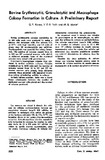| dc.contributor.author | Kaaya Godwin P. | |
| dc.contributor.author | Valli VE. | |
| dc.contributor.author | Maxie M G. | |
| dc.date.accessioned | 2013-06-18T08:24:06Z | |
| dc.date.available | 2013-06-18T08:24:06Z | |
| dc.date.issued | 1978-07 | |
| dc.identifier.citation | Can J Comp Med. 1978 Jul;42(3):322-6. | en |
| dc.identifier.uri | http://www.ncbi.nlm.nih.gov/pubmed/688074 | |
| dc.identifier.uri | http://erepository.uonbi.ac.ke:8080/xmlui/handle/123456789/35427 | |
| dc.description.abstract | Bovine erythrocytic colonies containing up to 300 cells each were produced by using a plasma clot technique with five percent CO2 at 37 degrees C. with high humidity and 2.5 units of sheep step III erythropoietin per milliliter. Erythropoietin was essential for colony formation. The number of colonies ranged from 24 to 823 per 10(5) nucleated marrow cells plated, in different animals. Some of the erythroid colonies were mixed with granulocytes. Granulocyte/macrophage colonies were produced in methyl cellulose cultures. Colonies contained up to 1000 cells and the number of colonies ranged from 13 to 981 per 10(5) nucleated marrow cells plated, from different animals. Glass adherent cells appeared to produce colony stimulating activity in culture. In both culture systems, there was a direct linear relationship between the number of nucleated marrow cells plated and the number of colonies produced | en |
| dc.language.iso | en | en |
| dc.publisher | University of Naitrobi | en |
| dc.title | Bovine erythrocytic, granulocytic and macrophage colony formation in culture. A preliminary report | en |
| dc.type | Article | en |
| local.publisher | School of Biological Sciences | en |

